The USS New Jersey (BB-62) is an Iowa-class battleship that has seen combat in World War II, the Korean War, the Vietnam War, and the Lebanese Civil War, making her one of the most decorated ships in the U.S. Navy.
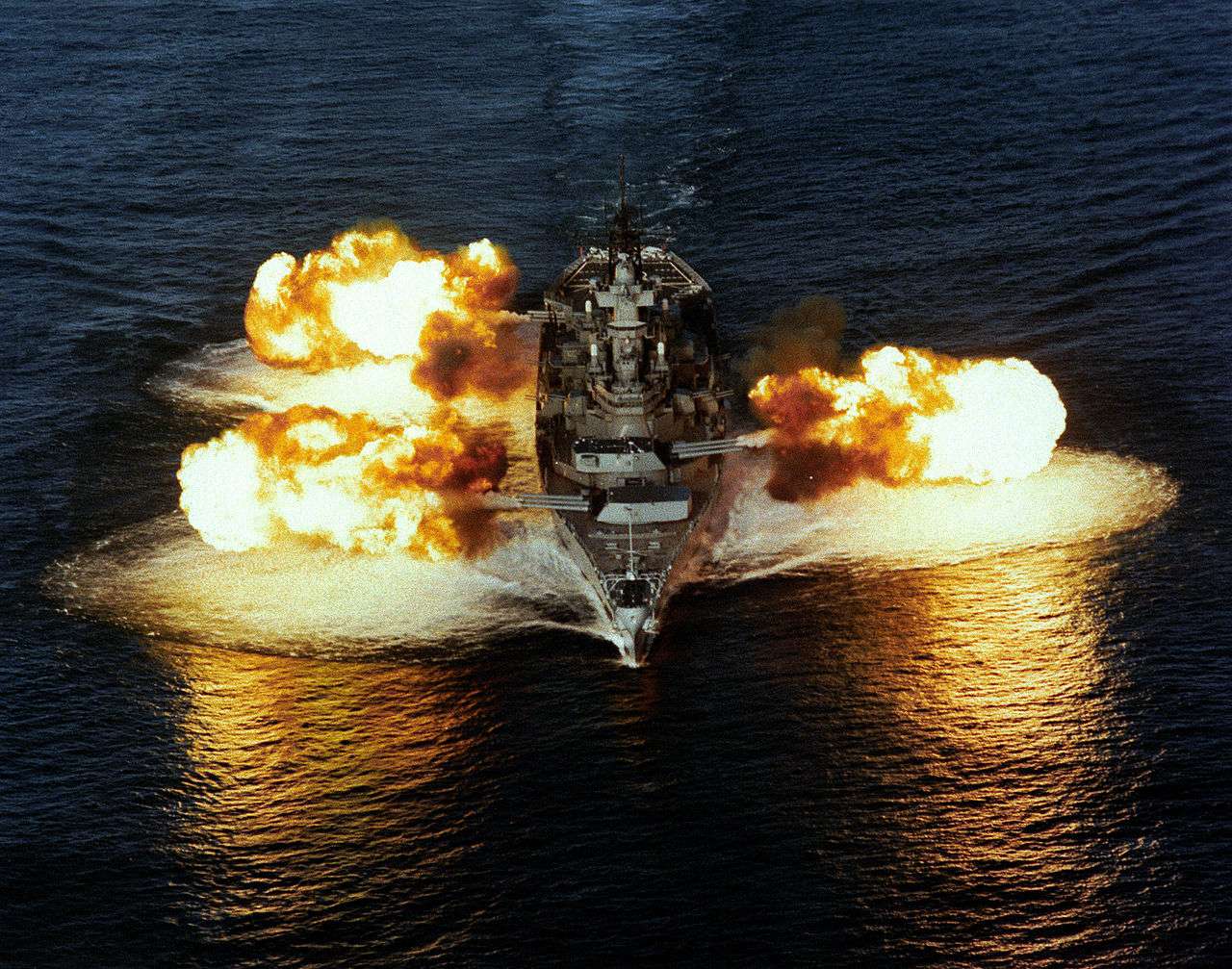
Commissioned in 1943, she combined formidable firepower with impressive speed and played a pivotal role in various naval operations across multiple decades.
Today, the USS New Jersey serves as a museum ship at the Camden Waterfront, preserving a rich legacy of naval history for future generations.
Design Of The USS New Jersey
The USS New Jersey was built at the Philadelphia Naval Shipyard in Philadelphia, Pennsylvania. Her keel was laid down on September 16, 1940, and she was launched on December 7, 1942.
She had an impressive length of 887.3 feet and a beam of 108.3 feet. Fitted with steam turbines and eight mammoth boilers, the USS New Jersey was engineered to reach speeds of up to 33 knots.
Her primary weapon system consisted of nine 16-inch/50 caliber Mark 7 guns. These guns were mammoth in size and capability, designed to hurl 2,700-pound armor-piercing shells over distances that exceeded 20 miles.
This firepower ensured that the New Jersey could engage enemy vessels and fortifications from a position of relative safety, all the while delivering devastating blows.
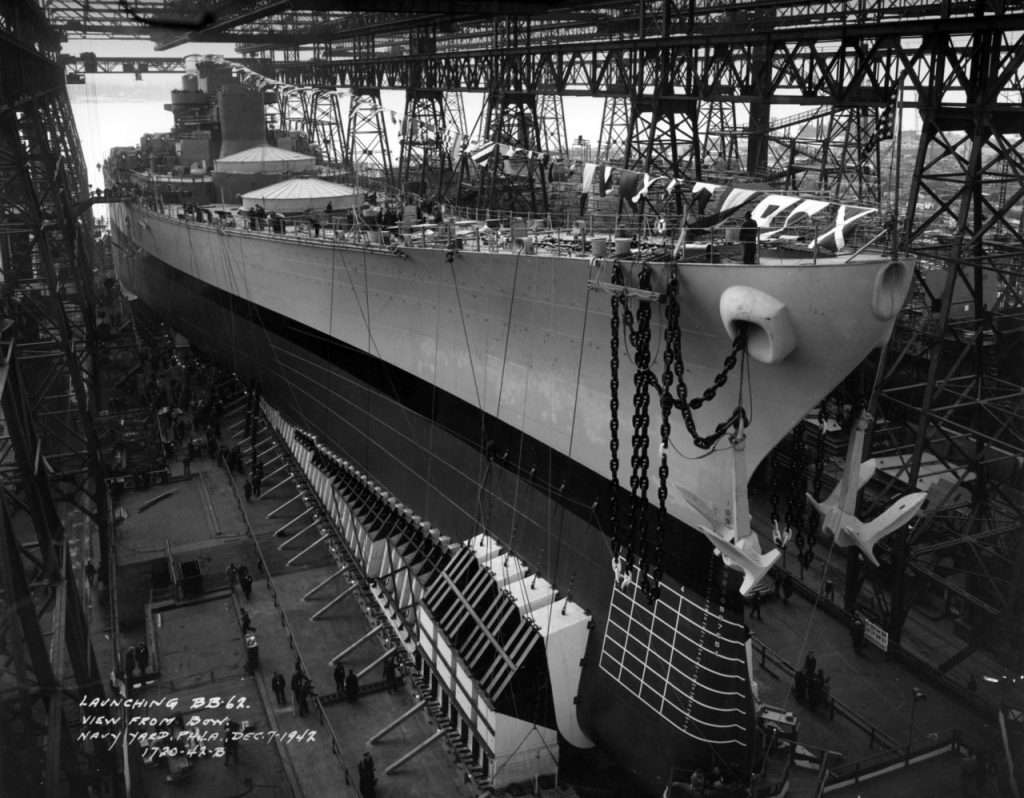
But the New Jersey was not solely reliant on her big guns. Her secondary battery comprised twenty 5-inch/38 caliber guns, designed for a range of purposes including warding off smaller enemy vessels and providing anti-aircraft defense.
Over her lifetime, these armaments saw several modifications. Recognizing the evolving nature of threats, especially from the air, the USS New Jersey was equipped with a plethora of anti-aircraft guns, eventually being upgraded to house missiles and advanced radar systems.
New Jersey In World War II
Upon her commissioning in 1943, the USS New Jersey was immediately thrust into the heart of the Pacific war zone. This was a strategic decision, given the growing need for heavy naval firepower to counter the Japanese Imperial Navy’s dominance.
The vast expanses of the Pacific Ocean required naval vessels that could not only project power but also protect the valuable aircraft carriers, which were pivotal in controlling airspace and launching aerial offensives.
Under Admiral Raymond Spruance’s Fifth Fleet, the USS New Jersey was not just a supporting asset but often took the central role in operations.
The Battle of the Philippine Sea, for instance, was a significant aerial combat phase where the primary goal was to ensure American carrier groups remained unharmed by Japanese aerial onslaughts.
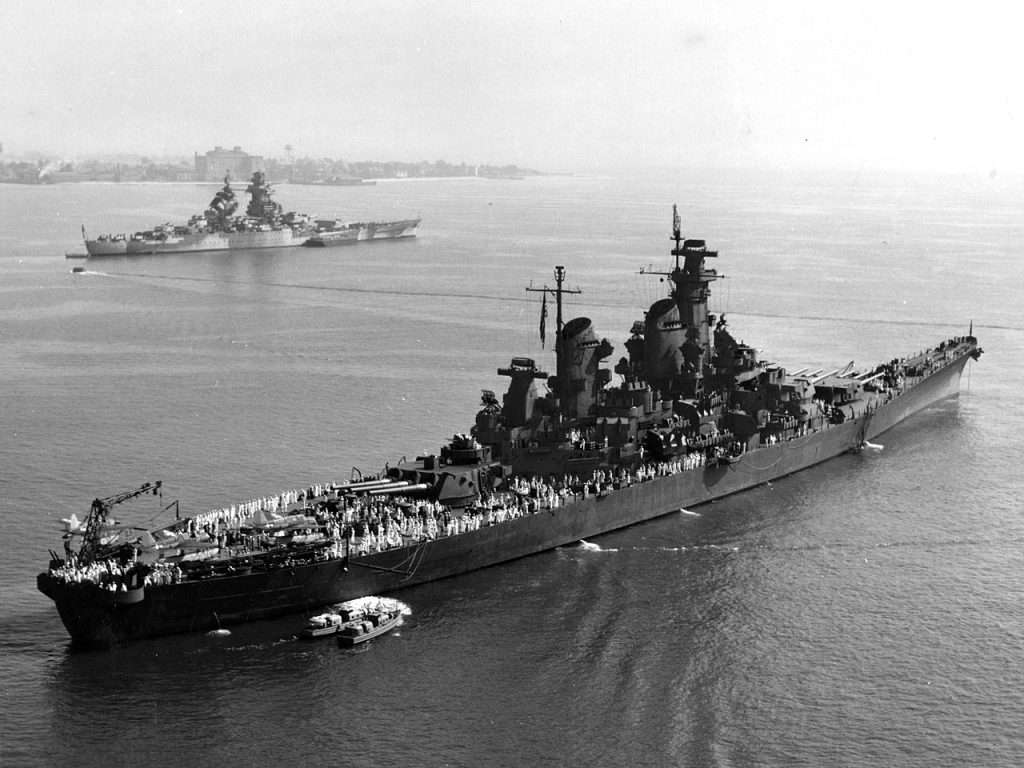 USS New Jersey anchored next to the French battleship Richelieu, 7 September 1943. The dark color of her hull, seen here, gained her the nickname ‘Black Dragon’.
USS New Jersey anchored next to the French battleship Richelieu, 7 September 1943. The dark color of her hull, seen here, gained her the nickname ‘Black Dragon’.
The New Jersey’s formidable anti-aircraft barrage and its 16-inch guns played a crucial role in thwarting Japanese aerial advances, offering a protective shield to American aircraft carriers. The ship’s capabilities meant it could engage enemy aircraft, support air operations with its own onboard aircraft, and still pose a threat to enemy surface vessels.
But the Battle of the Philippine Sea was just one facet of the New Jersey’s service during World War II. The ship’s contribution in the Battle of Leyte Gulf further highlighted her versatile combat capabilities.
As one of the largest naval battles in history, Leyte Gulf saw the New Jersey in various roles, from direct ship-to-ship combat to providing gunfire support for amphibious operations.
The ship’s involvement in assaults on Okinawa and Iwo Jima — two crucial island battles that formed the stepping stones for the eventual Allied push towards the Japanese mainland — further underscored her indispensable role.
At Iwo Jima and Okinawa, her guns supported thousands of Marines as they battled entrenched Japanese defenses, helping to pave the way for hard-fought victories on both islands.
Why is the USS New Jersey called the Black Dragon?
The ship got its name from its dark hull and how when it fired weaponry, it resembled a dragon breathing fire. The Big J or Black Dragon was an Iowa-class battleship that fought in World War 2. The Black Dragon fought in Western Pacific campaigns, Saipan and Tinian missions. It was the only battleship used during the Vietnam and Korean War.
Korean War
The Korean War, often dubbed the “Forgotten War,” unfolded in the wake of World War II as the Cold War’s geopolitical tension flared.
The USS New Jersey, fresh from its role in the Pacific theater of World War II, found itself redeployed in another major conflict, this time on the Korean Peninsula.
The post-World War II period saw a rapid de-escalation of military assets, with many battleships, including some of the Iowa-class, being decommissioned.
However, the outbreak of the Korean War in 1950 and the subsequent need for naval firepower in the Peninsula’s challenging terrains changed this dynamic.
The USS New Jersey was reactivated and sent to Korean waters.
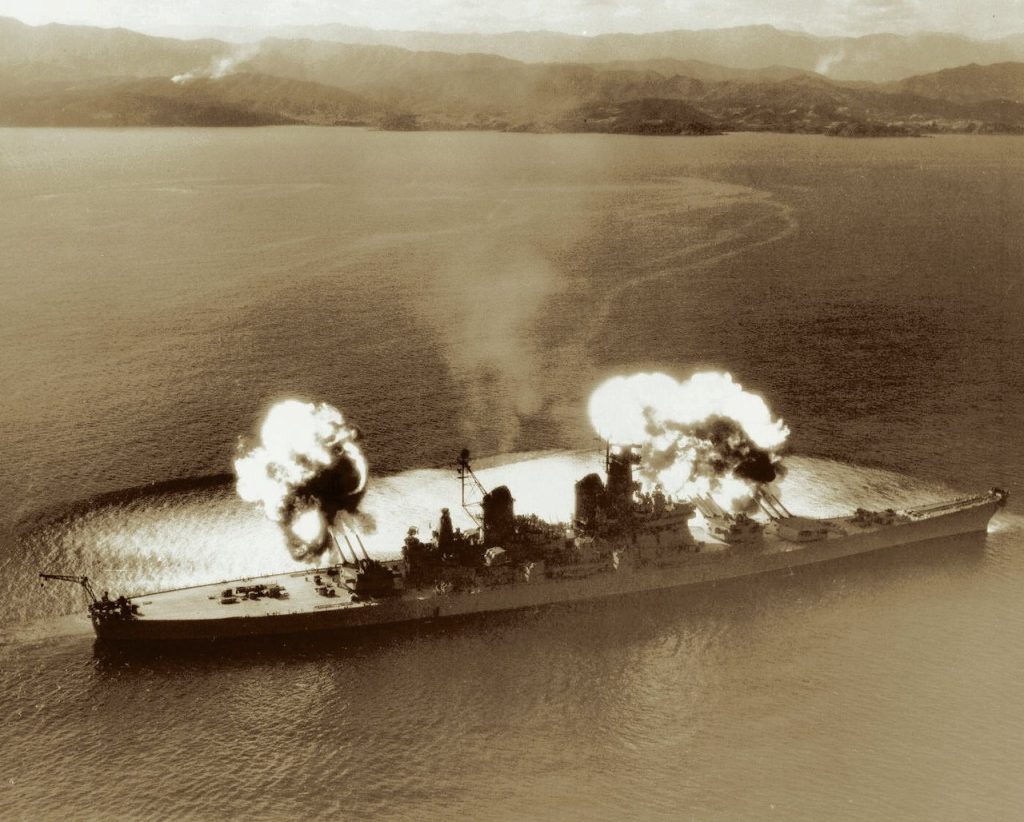 USS New Jersey fires nine of her 16 inch guns on enemy targets in Korea, 10 November 1951.
USS New Jersey fires nine of her 16 inch guns on enemy targets in Korea, 10 November 1951.
One of the critical operations during her deployment was in the coastal city of Wonsan. The city, under Communist control, posed a huge threat to the UN forces’ strategic movements.
USS New Jersey, with her array of heavy guns, provided gunnery support, launching bombardments that decimated enemy positions and played a crucial role in the subsequent recapture of the city.
Her 16-inch guns rained down shells, clearing pathways for ground forces and ensuring that the North Korean and Chinese troops had little room to maneuver or establish fortified positions.
However, Wonsan was just one of the many engagements for the USS New Jersey. Throughout the war, she served as a floating artillery base, moving along the Korean coast and providing much-needed fire support to UN troops on the ground.
What is the black dragon of the US Navy?
The US Navy ‘Black Dragon’ is the USS New Jersey. This ship was called ‘Black Dragon’ because it was difficult to see it at night.
This was due to its dark blue paint job. The Black Dragon joined the battles of WWII in 1944.
Moreover, the Black Dragon participated in almost all of the campaigns in the Pacific West during WWII.
Vietnam
The Vietnam War, spanning from the mid-1950s to the mid-1970s, represented a unique period in modern warfare, with complex geopolitical contexts, guerilla warfare, and an increasing reliance on technology.
Amidst this backdrop, the USS New Jersey was reactivated and deployed to take part in the conflict.
The Vietnam War posed a set of challenges distinct from the ship’s previous engagements. The conflict was marked by asymmetrical warfare, dense jungle terrains, and a heavily involved civilian population.
Reacting to the changing nature of the battlefield, the USS New Jersey underwent modifications in the 1960s.
Beyond her already formidable arsenal, she was equipped to carry modernized weaponry, including Tomahawk missiles and sophisticated anti-aircraft missiles.
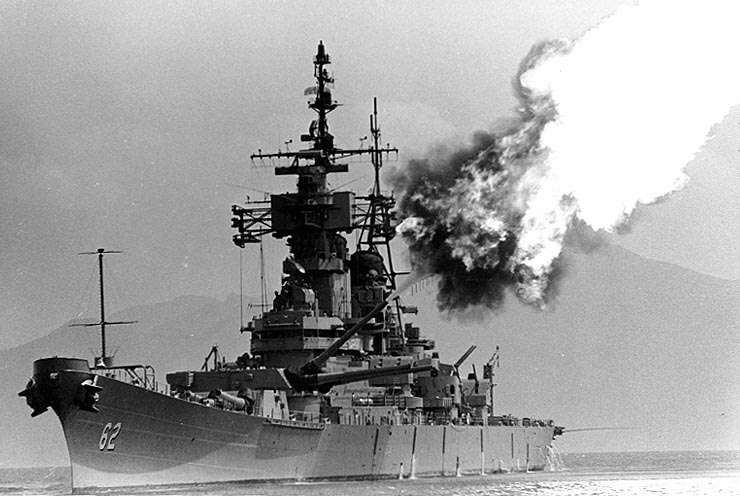 Firing her guns on enemy positions on the South Vietnamese Coast.
Firing her guns on enemy positions on the South Vietnamese Coast.
In Vietnam, the USS New Jersey Viet Cong and North Vietnamese positions to support the U.S. forces.
However, the USS New Jersey’s story did not conclude with Vietnam. The evolving geopolitical scenario of the 1980s saw her reactivation once more, this time amidst the tensions of the Lebanese Civil War.
Deployed off the coast of Lebanon in the early 1980s, the battleship, now a seasoned veteran of multiple wars, was tasked with providing naval gunfire support.
Decommissioning
The decision to decommission the USS New Jersey was reflective of the larger shifts in defense priorities and naval strategy. By the time of her last deactivation in 1991, technological advancements had ushered in a new age of warfare. Stealth technology, missile systems, and nuclear deterrence had transformed naval strategies, reducing the central role once held by battleships like the New Jersey.
While she had been adapted and upgraded several times to maintain her relevance on the battlefield, it was clear that the era of battleships as the primary naval asset was drawing to a close.
However, the decommissioning of the USS New Jersey was not an end, but a transformation. Recognizing her historical significance and the deep emotional connection she held for countless veterans and their families, the decision was made to preserve her as a museum ship.
Moored at the Camden Waterfront in New Jersey, she now stands as a tangible link to the past, offering visitors a chance to walk her decks, explore her cabins, and get a firsthand look at the machinery that powered this titan.
News
Miley Cyrus N-de & S*xy Collection (10 Photos)
Miley Cyrus, the American Fappening celeb, is in a new set of nude and sexy pics, showin’ off her stuff! Instagram: https://www.instagram.com/mileycyrus/
Exactly 6 years ago, Taylor Swift’s “MV that made the audience talk a lot” Delicate was released globally.
After exactly 1 year and 4 months of release, Taylor Swift’s “Look What You Make Me Do” has officially reached 1 billion views on YouTube. On December…
Sylvester Stallone’s model daughter Sistine, 17, looks just like her mother Jennifer Flavin, 46, as they step out in matching denim shorts in Antibes
Sylvester Stallone is currently soaking up the sun in Antibes, France, with his stunning wife and daughters and the family resemblance is clear to see. The Rocky…
Miley Cyrus’ Fans Speculate That She Got ‘Plastic Surgery’ After Seeing Before-And-After Photos From 2012 To 2024
Miley Cyrus has evolved from a Disney darling to a full-fledged rockstar, and many of her fans feel like they’ve grown up with her. Over time, the “Flowers”…
Arnold Schwarzenegger spotted filming Netflix series in Elora
Arnold Schwarzenegger, the illustrious bodybuilder, action star, and former governor, can now add another highlight to his extensive résumé: a visit to Elora. Schwarzenegger was spotted on…
Arnold Schwarzenegger Was Honored As An Outstanding Bodybuilder Who Redefined The Perfect Physique
Arnold Schwarzenegger, the legendary seven-time Mr. Olympia, stands as the epitome of the bodybuilding realm, forever etched in history as the most influential bodybuilder of all time….
End of content
No more pages to load











